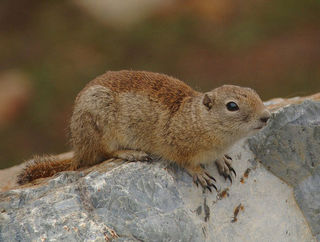
Author: Yathin S Krishnappa
Belding's ground squirrel
Order : Rodentia
Suborder : Sciurognathi
Family : Sciuridae
Subfamily : Sciurinae
Species : Spermophilus beldingi
The Belding's ground squirrel is listed as Least Concern (LR/lc), lowest risk. Does not qualify for a more at risk category. Widespread and abundant taxa are included in this category, on the IUCN Red List of Threatened Species
Namings for the Belding
A young / baby of a Belding is called a 'pup, kit or kitten'. The females are called 'doe' and males 'buck'. A Belding group is called a 'dray or scurry'.Countries
United StatesSome facts about the
Belding's ground squirrel
Adult weight : 0.29 kg (0.638 lbs)
Female maturity :365 days
Male maturity : 547 days
Gestation : 26 days
Weaning : 24 days
Litter size : 6
Litters per year : 1
Weight at birth : 0.007 kg (0.0154 lbs)
Weight at weaning : 0.055 kg (0.121 lbs)
Basal metabolic rate : 1 W
Body mass : 0.294 kg (0.6468 lbs)
Temperature : 35.85 °C (96.53 °F)
Facts about the Belding's ground squirrel
Belding's ground squirrel, Spermophilus beldingi, is native to parts of Utah, Idaho, Oregon, Nevada, and California. (Full text)
The Belding ground squirrel (Spermophilus beldingi) is common in eastern Oregon. (Full text)
Belding's Ground Squirrel Spermophilus beldingi is a relatively small ground squirrel with a head to tail length of 230-300mm.
Belding's Ground Squirrel or Spermophilus beldingi is listed on the IUCN Red list (1996) as Lower Risk/Least Concern . (Full text)
Belding’s ground squirrel (Spermophilus beldingi) is one of the interesting species of mammals that recognizes
Belding’s ground squirrel (Spermophilus beldingi) is a diurnal rodent that lives
The Belding's Ground Squirrel is from the order Rodentia. (Full text)
Belding's Ground Squirrel ClassOrderFamilySpecies Mammalia Rodentia Sciuridae Spermophilus beldingi Belding's Ground Squirrel Distribution, Abundance, and Seasonality Belding's ground squirrel is common in its California range, which extends along the Sierra Nevada from Tulare and Inyo cos. (Full text)
Where their ranges overlap, the two species are easy to distinguish: Belding's ground squirrel is 10 inches long and has a wide band of brown-gray down its back, contrasting with grayish sides; the Columbian ground squirrel is half again as long (15 inches) as Belding's and has a mottled gray back.
Belding's Ground Squirrel Belding's ground squirrel is common in its California range, which extends along the Sierra differences in the pattern of hibernation in the ground squirrel Spermophilus beldingi Thirteen-lined Ground Squirrel Thirteen-lined Ground Squirrel.
Belding’s ground squirrel is the reddest colored squirrel of Nevada.
Habitat: Belding’s ground squirrel is found in a large portion of Northwestern United States.
" Not much bigger than a beer can, the Belding's ground squirrel is a nettlesome problem for hay growers and cattle ranchers all over the West.
Granholm DISTRIBUTION, ABUNDANCE, AND SEASONALITY Belding's ground squirrel is common in its California range, which extends along the Sierra Nevada from Tulare and Inyo cos.
The Belding's Ground Squirrel is common in farm and rangeland areas of the county, and is a particular nuisance in irrigated hay fields.
Belding’s ground squirrels are highly social animals found in meadows, sagebrush, and of course, campgrounds throughout the high Sierra. (Full text)
Female Belding's ground squirrels are able to discriminate between littermate sisters, non-littermate sisters, and other female squirrels, and this capacity to recognize kin appears to facilitate nopotistic nepotistic interactions among females. (Full text)
Belding's ground squirrels are group-living diurnal rodents that inhabit alpine and subalpine meadows of the western United States. (Full text)
Over their range in western USA, Belding's ground squirrels are common in high alpine meadows (Jenkins and Eshelman, 1984), which are invariably covered with a meter or more of snow in early spring when they emerge from hibernation. (Full text)
Belding’s ground squirrels are most often located in grassy meadows and riparian areas.
So far, Belding's ground squirrels are the champions of kin-sniffing, but many more species remain to be investigated.
Belding’s ground squirrels are also very dependent on their burrows for predator protection.
More animals beginning with B
